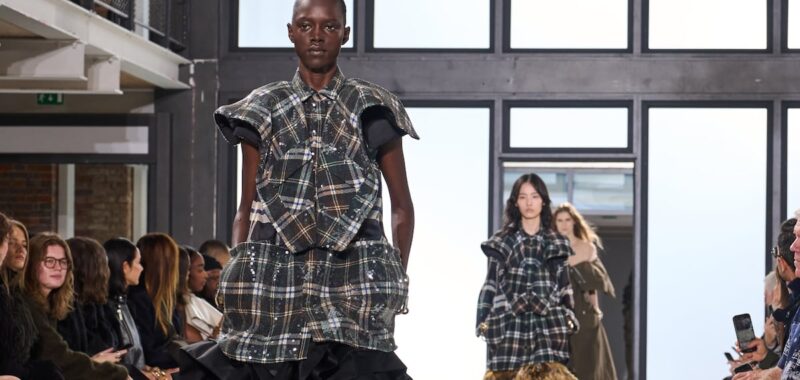PARIS â Junya Watanabe said the movie Ex Machina was on his mind when he was working on his new collection. Its main character is a beautiful humanoid robot called Ava, and she was the inspiration for another of Junyaâs sculptural fusions of human and synthetic. Itâs always been his own particular alchemy to transform the most functional machine-made materials into flights of fashion fancy, and so it was on Saturday when he used polyester mesh from Japanese motorbike clothing brand Degner and recycled god-knows-what from Berlin bag brand Innerraum, among other industrial textiles, to produce looks of extraordinary, almost classical elegance.
The way Innerraum describes its product on its webpage is, âevery single object is experienced as an extension of the body.â Bags are not made but âassembled,â the same way Ava was assembled, or Dr. Frankenstein made his monster. Thatâs how Junya constructed his dresses, as complex collages which remade his models. Also in the Frankenstein vein, the sepulchral strain of Goth in the collection. A pile of skulls decorated a t-shirt. Black lace looked like it had been tarred. The formal silhouettes had an undertow of haute couture: panniers, peplums and fichus, full skirts, puff sleeves and trains. Imagine an opera coat constructed from backpacks, with the straps still attached. Zips, straps and buckles were significant because, as they signposted the origins of the recycled materials, they also underscored the creativity in transforming those materials.

âI feel that abnormal clothing is necessary in our everyday life,â was Junyaâs post-show dictum. But I imagined Ava assembling these âabnormalâ clothes from whatever apocalypse-proof synthetic scraps were left after âtheyâ dropped the Big One. Isamaya Ffrench did a gorgeous job with the anomic android makeup. And Michel Gaubert set the show to a re-recorded âI Feel Love,â which reminded me that the most fabulous scene in Ex Machina is the mad scientist dancing disco with one of his humanoids. Reason to Love Junya Watanabe #243.
Fashion wunderkind Duran Lantink makes an effortless segue from Junyaâs recycling, because he got his start by creating hybrid pieces from repurposed deadstock like trench coats and bomber jackets. That got him thinking about silhouette. Question: How can I blow up a trench coat? Answer: With a computer and a very adaptable design team. Three years later, Lantinkâs got the ANDAM Special Prize and the LVMH Karl Lagerfeld Prize under his belt, and heâs a finalist in the 2024 Woolmark Awards.
But, at 36, heâs still young in the business and thereâs not much money, so, for Spring 2025, Lantink made the budget-conscious decision that, necessity being the mother of invention, he was going to make his collection out of cotton t-shirting. âLetâs try and redefine what you can do with t-shirts,â became the guiding principle. Anything, it seems. T-shirt bombers, t-shirt trench, t-shirt bra top. On and on.

Lantink first caught fashionâs eye with his cartoonishly exaggerated proportions. That blown-up trench coat, remember? A year ago, the mutations looked like they might be a gimmick. Now, Iâm calling them a physical realisation of independent fashion thinking. And Lantink sees more people trying to do similarly independent things in fashion. âQuiet luxury is so boring, isnât it,â he muses. Heâs focused on his âgimmickâ, perfecting shapes, making them smaller, aware that people might actually want to wear his clothes in the street, or at the beach, or on a night out. When I say âsmallerâ, there was still plenty of pneumatic uplift in his latest designs, so it may just be the inevitable diminution of shock value that made them look so much more desirable. The summery candy-striping helped. But as a pair of white denim shorts chugged past with two fins of fabric jutting provocatively forward, I slipped into âwantâ mode (irrationality being a key component of fashion desire). And the rest of the collection had the same skew-whiff appeal. âJuttingâ was actually the right descriptive for shoulders, hips, breasts, knees, elbows and the bag hats that somehow ended up on modelsâ heads.
They made the audience smile, and that, for Lantink, is everything. âItâs a way to communicate,â he said. âJoy and fun is really important. I wake up excited to create new forms, new silhouettes, so I hope people adapt to that.â There was standing room only at his show on Sunday. Theyâre adapting.

I remember when Chitose Abe had the same âIâve never seen that beforeâ impact when she launched Sacai in Paris 15 years ago. The brand is actually 25 years old, so, to mark the moment, Abe claimed she was going back to the source âto recreate familiar archetypes as something new.â But it wasnât a simple revamp. Technology has moved everything on. The business has changed. Sacai just opened an office in Paris. Maybe that injected a little French je ne sais quoi into the collection, with its marinier moment and crisp white cravat-ish collars. No, Abe countered. She did sailor stripes a long time ago. And the innate elegance of menâs tailoring details has always been part of her vocabulary. The two notions came together in a gold-buttoned navy jacket with an embroidered monogram on the pocket. Very Commodore Chitose.
Abeâs USP is her fiendish ingenuity with hybrid garments. If there was nothing as radical as those complicated-looks-that-were-actually-one-piece from a few seasons ago, the collection she showed on Monday was a reminder of her facility for turning layers of fabric into airy constructions with a ruffle, a bustle, or a flurry of thick fringing that gave a balletic boost to a skirt, and a floor mop wit to a pair of mules. Abeâs outerwear is always peerless. Here, she chopped the sleeves off parkas to create a kind of strong samurai silhouette. But there was always that perfectly elegant proportion that is clearly in her genes. I think an MA-1 jacket is one of the quintessential modern classics. It practically defies improvementâ¦except when Chitose Abe gets her hands on it.

